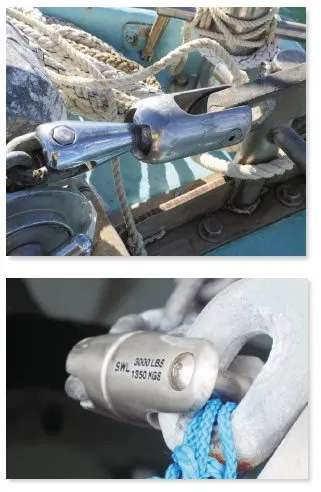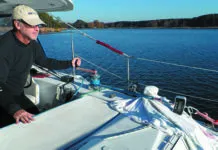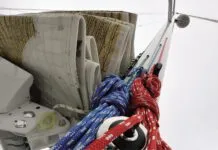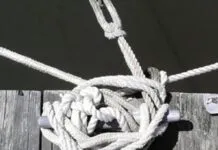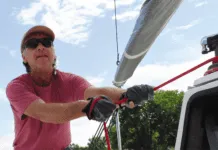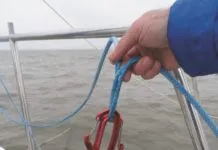Anchor Snubber Shock Load Test
In the past, a snubber was simply a device incorporated into the anchor rode to take the load off the windlass. We recently tested different types of snubber material, including nylon octoplait, rock-climbing rope, and rubber. Our tests were conducted as part of a long-term project on anchor-snubber selection, deployment, and care. Although there are some pre-fabricated snubbers on the market, most cruisers make their own, so this initial comparison was more generic in scope, focusing on common materials and designs.
Handling Anchors on Boats Without Anchor Lockers
How do you keep an anchor and its rode at the ready if you don’t have an anchor locker up at the bow? It’s...
Advice on Buying a Pre-Owned Anchor
Since defects are usually obvious, anchors is one category of gear in which “what you see is what you get.” Certainly, there are counterfeits and home-welded one-offs that you’ll want to avoid, but the fakes and do-it-yourself anchors are usually easy to distinguish.
Before you buy a used anchor, you should have a very clear picture of the size, type, and brand of anchor will best suit your needs. Depending on the specific anchor you seek, you can save 30 to 50-percent on cost by purchasing a pre-owned anchor instead of a new one.
Mud Anchoring Wisdom
For as long as I can remember, and probably for generations, it has been Chesapeake Bay lore that the longer an anchor soaks the...
Checking Rope Strength
We like nylon for docklines, anchor rode and chain snubbers because it stretches, absorbing jolts that would otherwise be transferred to the boat and...
Superlight Anchors: Not Just for Racers
The anchors a sailor chooses to carry onboard are often a compromise between weight and necessity. Since different anchor types are designed to work best in different conditions, it is a good idea to carry several anchors of different designs. So where does a lightweight alloy anchor fit in the hierarchy of cruising anchors? Practical Sailor looked at the weight, performance, design, and price of lightweight, alloy anchors from Spade, Fortress, Manson, and Anchor Right.
How (Not) to Tie Your Boat to a Dock
No sailor can resist the temptation to look over another sailors work, and nothing draws the eye faster than your neighbors docklines. We like to know our boat and our neighbors boats will be where we left them when we return, not rubbing together or worse. Sometimes, however, a stroll down the dock makes us nervous. This gallery of rogue docklines represents only a taste of what PS tester Drew Frye found within a short walk of his slip. How many of these will come loose during the next storm?
Master the Sailing Basics: Never Stop Learning the Little Things
Seamanship is about big concepts and small skills. They work together, but we see them differently and they represent different types of learning. Big...
Practical Sailor Classic: The Load on Your Rode
Our time spent testing anchors has prompted some important musings; we offer the following thoughts regarding the forces and factors to be considered before purchasing anchors and rodes.
Anchor Rodes for Smaller Sailboats
The usual advice for anyone seeking all-rope anchor rode is usually to just get some three-strand nylon anchor. The makes sense. Three-strand nylon is inexpensive, wears best, and is easy to splice. But one size, or even one type of rope, does not necessarily fit all situations.


































